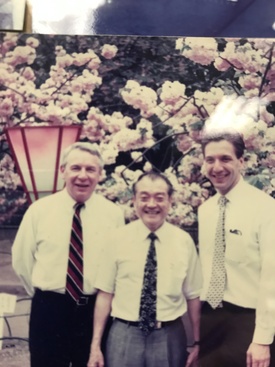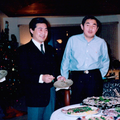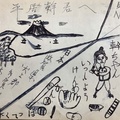Employment with Amerex
As the Japanese economy began to re-emerge during the postwar years, there was an urgent need for employees who could speak English well. This became a lifesaving economic opportunity for many of the exiles, even those lacking a strong formal education. Tak was one of those who made the best of this situation, using a combination of native wit, natural curiosity, good social skills, network building, and a willingness to offer his assistance to anyone who needed it.1
After four years of working in the sheltered environment of the Occupation Forces, he was beginning to feel restless and anxious about his future. This led to his being introduced by an American army officer to a private sector company affiliated with the Sogo Department Store chain called the Amerex Trading Company. He worked there from 1950 to 1952.
As time went by I started to feel that I was leading a protected life and that the real world was outside the Occupation Forces. I cannot recall how it came about, but I must have mentioned this to one of the officers and one day he asked me if I wanted to try for an outside job and if so, he could introduce me to a Japanese business executive. But, it was on the proviso that I not tell anyone that he had helped me get a job outside of the Occupation Forces lest he get in trouble with his superiors who valued my services and wouldn’t want to see me leave.
I was beginning to think that the occupation would not last forever and that my future was elsewhere, so I took him up on it and he introduced me to the Japanese manager of Amerex Trading Company, owned and operated by some Jewish Americans who had fled Russia after World War II and emigrated to the U.S.A. I was hired and started working in a civilian environment. The main business of the company was to import supplies, mainly foodstuffs for sale to specialty shops which at that time catered to foreigners who were not affiliated with the Occupation Forces.
Being naturalized Americans, the president and vice president of the company were proficient in the English language, but it was not their mother tongue. One day, they called me into their office and said that they couldn’t find in the dictionary a particular word in a letter they had received. I took a look at it and told them that it was a misspelt word and it should have been spelt so and so. I can’t recall what the word was, but they soon found it in the dictionary. That happening helped me later in the office. Whenever the Japanese manager would ask me to translate at times long and not really necessary material, the president would tell the manager not to “burden Tak with such minor chores as we have more important things for him to do".
In 1952, two years after I started working at the company, I was sent to Osaka as manager of a joint business specialty store with a Japanese department store. At this point, perhaps I should explain the term, “specialty store.” In those days, there were PXs (post exchanges) which were stores for occupation force personnel, civilians (civil service personnel) and their dependents, where they could purchase all the necessities of life, but there was a foreign civilian group who did not come under the category of ‘occupation force civilians.’ They were non-Japanese who were living in Japan when the War ended. Some were Italian and German military personnel who were stranded in Japan and continued to live there. Specialty stores were set up to supply the needs of this third-party group and the currency used was the U.S. dollars script. To deal with the banks in script, there was a need for a foreigner to sign checks, etc. and that is probably how I got the job.
Employment with Sogo Department Store

In 1952 Tak started working for the Sogo Department Store chain in Osaka where he continued for seven years. It was here that he met his wife who was also an employee of Sogo. They would have 3 daughters to whom they gave names that sound both English and Japanese: Amy, Alisa, and Serena.
The present Japanese department chain store, Sogo, with which the joint specialty shop was established, had their main store taken over by the Occupation Forces and was being used as a PX. As time went by and the peace treaty was signed, the PX was returned to the Japanese owners and the specialty shop was closed, and I was invited by Sogo to become their employee, which I accepted. This really started my career in the Japanese business world. I worked there from November 1952 to June 1959. I don’t know what went on behind the scenes, but the Japanese manager of Amerex Trading Co. later ended up becoming a vice president of Sogo Department Store.
A little aside: Years later, an article appeared in the Reader’s Digest magazine about a German journalist stationed in Japan who was a spy. The article also implicated this Japanese manager at Amerex in the spy’s activities. I recall hearing that the manager was furious and denied having anything to do with it. I would not be surprised if he had something to do with it as there was something about this man that was difficult to figure out. To me, he had a mysterious aura. It was difficult to get to know him really well.
Notes:
1. See Tak’s comments about this to Tatsuo Kage in Uprooted Again: Japanese Canadians Move to Japan After World War II, pp. 40-41.
* This series is an abridged version of a paper titled, “A Japanese Canadian Teenage Exile: The Life History of Takeshi (Tak) Matsuba,” published in Language and Culture: The Journal of the Institute for Language and Culture, Konan University, March 2020.
© 2020 Stanley Kirk






